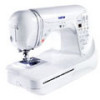Brother International PC-210 Users Manual - English - Page 33
Checking the needle, combination of the fabric, thread
 |
View all Brother International PC-210 manuals
Add to My Manuals
Save this manual to your list of manuals |
Page 33 highlights
CONTENTS GETTING READY SEWING BASICS UTILITY STITCHES Memo ● The smaller the thread number, the thicker the thread, and the larger the needle number, the thicker the needle. ● Use the ball point needle when sewing on stretch fabrics or fabrics where skipped stitches easily occur. ● Use a 90/14 to 100/16 needle with transparent nylon threads, regardless of the fabric being sewn. ● A 75/11 needle is already installed when the sewing machine is purchased. CAUTION ● The appropriate fabric, thread and needle combinations are shown in the table on the previous page. If the combination of the fabric, thread and needle is not correct, particularly when sewing thick fabrics (such as denim) with thin needles (such as 65/9 to 75/11), the needle may bend or break. In addition, the stitching may be uneven or puckered or there may be skipped stitches. Checking the needle Sewing with a bent needle is extremely dangerous since the needle may break while the machine is being operated. Before using the needle, place the flat side of the needle on a flat surface and check that the distance between the needle and the flat surface is even. 1 2 1 Flat side 2 Needle type marking ■ Correct needle 1 1 Flat surface ■ Incorrect needle If the distance between the needle and the flat surface is not even, the needle is bent. Do not use a bent needle. 1 1 Flat surface APPENDIX INDEX Replacing the Needle 27















